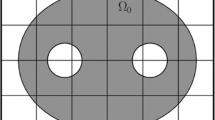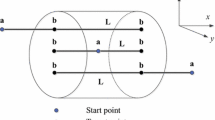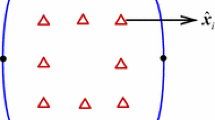Abstract
A line integration boundary element method (LIBEM) is proposed for three-dimensional elastostatic problems with body forces. The method is a boundary-only discretization method like the traditional boundary element method (BEM), and the boundary elements created in BEM can be used directly in the proposed method for constructing the integral lines. Finally, the body forces are computed by summing one-dimensional integrals on straight lines. Background cells can be used to cut the lines into sub-lines to compute the integrals more easily and efficiently. To further reduce the computational time of LIBEM, the fast multipole method is applied to accelerate the method for large-scale computations and the details of the fast multipole line integration method for 3D elastostatic problems are given. Numerical examples are presented to demonstrate the accuracy and efficiency of the proposed method.























Similar content being viewed by others
References
Jaswon, M.A., Symm, G.T.: Integral Equation Methods in Potential Theory and Elastostatics. Oxford University Press, Oxford (1977)
Chati, M.K., Mukherjee, S., Mukherjee, Y.X.: The boundary node method for three-dimensional linear elasticity. Int. J. Numer. Methods Eng. 46(8), 1163–1184 (1999)
Li, X., Zhu, J.: A Galerkin boundary node method and its convergence analysis. J. Comput. Appl. Math. 230(1), 314–328 (2009)
Miao, Y., Wang, Y.-H.: An improved hybrid boundary node method in two-dimensional solids. Acta Mech. Solida Sin. 18(4), 307–315 (2005)
Miao, Y., Wang, Y.-H.: Meshless analysis for three-dimensional elasticity with singular hybrid boundary node method. Appl. Math. Mech. 27(5), 673–681 (2006)
Miao, Y., et al.: Multi-domain hybrid boundary node method for evaluating top-down crack in Asphalt pavements. Eng. Anal. Bound. Elem. 34(9), 755–760 (2010)
Miao, Y., et al.: Dual hybrid boundary node method for solving transient dynamic fracture problems. Comput. Model. Eng. Sci. (CMES) 85(6), 481–498 (2012)
Zhang, J., et al.: A boundary face method for potential problems in three dimensions. Int. J. Numer. Methods Eng. 80(3), 320–337 (2009)
Zhou, F., et al.: Shape variable radial basis function and its application in dual reciprocity boundary face method. Eng. Anal. Bound. Elem. 35(2), 244–252 (2011)
Ingber, M.S., Mammoli, A.A., Brown, M.J.: A comparison of domain integral evaluation techniques for boundary element methods. Int. J. Numer. Methods Eng. 52(4), 417–432 (2001)
Koehler, M., Yang, R., Gray, L.J.: Cell-based volume integration for boundary integral analysis. Int. J. Numer. Methods Eng. 90(7), 915–927 (2012)
Zhou, W., et al.: A fast multipole method accelerated adaptive background cell-based domain integration method for evaluation of domain integrals in 3D boundary element method. Eng. Anal. Bound. Elem. 67, 1–12 (2016)
Nardini, D., Brebbia, C.: A new approach to free vibration analysis using boundary elements. Appl. Math. Model. 7(3), 157–162 (1983)
Zhou, F., et al.: A dual reciprocity boundary face method for 3D non-homogeneous elasticity problems. Eng. Anal. Bound. Elem. 36(9), 1301–1310 (2012)
Neves, A., Brebbia, C.: The multiple reciprocity boundary element method in elasticity: a new approach for transforming domain integrals to the boundary. Int. J. Numer. Methods Eng. 31(4), 709–727 (1991)
Ochiai, Y., Kobayashi, T.: Initial strain formulation without internal cells for elastoplastic analysis by triple-reciprocity BEM. Int. J. Numer. Methods Eng. 50(8), 1877–1892 (2001)
Ochiai, Y.: Two-dimensional unsteady heat conduction analysis with heat generation by triple-reciprocity BEM. Int. J. Numer. Methods Eng. 51(2), 143–157 (2001)
Ochiai, Y.: Three-dimensional heat conduction analysis of inhomogeneous materials by triple-reciprocity boundary element method. Eng. Anal. Bound. Elem. 51, 101–108 (2015)
Ochiai, Y.: Three-dimensional thermo-elastoplastic analysis by triple-reciprocity boundary element method. Eng. Anal. Bound. Elem. 35(3), 478–488 (2011)
Gao, X.-W.: The radial integration method for evaluation of domain integrals with boundary-only discretization. Eng. Anal. Bound. Elem. 26(10), 905–916 (2002)
Gao, X.-W.: Evaluation of regular and singular domain integrals with boundary-only discretization—theory and Fortran code. J. Comput. Appl. Math. 175(2), 265–290 (2005)
Fata, Nintcheu: Treatment of domain integrals in boundary element methods. Appl. Numer. Math. 62(6), 720–735 (2012)
Fata, S.N.: Boundary integral approximation of volume potentials in three-dimensional linear elasticity. J. Comput. Appl. Math. 242, 275–284 (2013)
Hematiyan, M.: A general method for evaluation of 2D and 3D domain integrals without domain discretization and its application in BEM. Comput. Mech. 39(4), 509–520 (2007)
Hematiyan, M.: Exact transformation of a wide variety of domain integrals into boundary integrals in boundary element method. Commun. Numer. Methods Eng. 24(11), 1497–1521 (2008)
Khosravifard, A., Hematiyan, M.R.: A new method for meshless integration in 2D and 3D Galerkin meshfree methods. Eng. Anal. Bound. Elem. 34(1), 30–40 (2010)
Hematiyan, M., Khosravifard, A., Liu, G.: A background decomposition method for domain integration in weak-form meshfree methods. Comput. Struct. 142, 64–78 (2014)
Liu, Y.: A new fast multipole boundary element method for solving large-scale two-dimensional elastostatic problems. Int. J. Numer. Methods Eng. 65(6), 863–881 (2006)
Liu, Y., Nishimura, N.: The fast multipole boundary element method for potential problems: a tutorial. Eng. Anal. Bound. Elem. 30(5), 371–381 (2006)
Wang, H., Yao, Z.: A new fast multipole boundary element method for large scale analysis of mechanical properties in 3D particle-reinforced composites. Comput. Model. Eng. Sci. 7(1), 85–95 (2005)
Wang, H., Yao, Z.: A rigid-fiber-based boundary element model for strength simulation of carbon nanotube reinforced composites. Comput. Model. Eng. Sci. (CMES) 29(1), 1–13 (2008)
Zhang, J., Tanaka, M.: Adaptive spatial decomposition in fast multipole method. J. Comput. Phys. 226(1), 17–28 (2007)
Of, G., Steinbach, O., Urthaler, P.: Fast evaluation of volume potentials in boundary element methods. SIAM J. Sci. Comput. 32(2), 585–602 (2010)
Ding, J., Ye, W., Gray, L.: An accelerated surface discretization-based BEM approach for non-homogeneous linear problems in 3-D complex domains. Int. J. Numer. Methods Eng. 63(12), 1775–1795 (2005)
Steinbach, O., Tchoualag, L.: Fast Fourier transform for efficient evaluation of Newton potential in BEM. Appl. Numer. Math. 81, 1–14 (2014)
Wang, Q., Miao, Y., Zheng, J.: The hybrid boundary node method accelerated by fast multipole expansion technique for 3D elasticity. Comput. Model. Eng. Sci. 70(2), 123–151 (2010)
Fu, Y., et al.: A fast solution method for three-dimensional many-particle problems of linear elasticity. Int. J. Numer. Methods Eng. 42(7), 1215–1229 (1998)
Wang, Q., Miao, Y., Zhu, H.: A fast multipole hybrid boundary node method for composite materials. Comput. Mech. 51(6), 885–897 (2013)
Wang, Q., et al.: An O (N) fast multipole hybrid boundary node method for 3D elasticity. Comput. Mater. Contin. 28(1), 1–25 (2012)
Saad, Y., Schultz, M.H.: GMRES: a generalized minimal residual algorithm for solving nonsymmetric linear systems. SIAM J. Sci. Stat. Comput. 7(3), 856–869 (1986)
Acknowledgements
Financial support for the project from the National Natural Science Foundation of China (No. 51609181), National Natural Science Funds for Excellent Young Scholars (No. 51322905) and the National Key Research and Development Program of China (No. 2016YFC0401900) are acknowledged.
Author information
Authors and Affiliations
Corresponding author
Rights and permissions
About this article
Cite this article
Wang, Q., Zhou, W., Cheng, Y. et al. The Boundary Element Method with a Fast Multipole Accelerated Integration Technique for 3D Elastostatic Problems with Arbitrary Body Forces. J Sci Comput 71, 1238–1264 (2017). https://doi.org/10.1007/s10915-016-0335-1
Received:
Revised:
Accepted:
Published:
Issue Date:
DOI: https://doi.org/10.1007/s10915-016-0335-1




